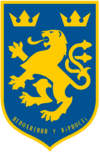Ravka
Ravkan Republic Равканська Республіка | |
|---|---|
| Motto: Непохитний у вірності | |
| Capital and largest city | Rivne |
| Official languages | Ravkan |
| Recognised regional languages | Masovian |
| Demonym(s) | Ravkan |
| Government | Unitary Parliamentary republic |
| Area | |
• Total | 835,989 km2 (322,777 sq mi) |
| Population | |
• 2022 census | 90,134,503 |
| GDP (nominal) | 2022 estimate |
• Total | ₳3,176,877,781,100 |
| Currency | Lei (₳) (RL) |
| Date format | dd-mm-yyyy CE |
| Driving side | right |
| Calling code | +67 |
| ISO 3166 code | RVK |
| Internet TLD | .rvk |
Ravka, officially the Ravkan Republic (Ravkan, is a country located in southern central Eracura. It is bordered to the north by Acrea and to the west by Drazhynskia. Its southern coast borders the Sundering Sea. Ravka has a primarily temperate climate, with a warm mediterannean coast along the Gulf of Seyne to the southeast. It has a land area of 835,989 km², and a population of just over 110 million. First settled by various ethnolinguistic groups, modern Ravka was largely inhabited by proto-Slavic peoples by early antiquity. Extremely arable land allowed large agricultural settlements to grow rapidly, and easy access to rivers allowed ancient Ravkans to freely trade their excess crops with various other peoples. Ravka was fully incorporated by the Acrean Empire by 130 BCE and remained a core territory until the Empire's collapse. No unified Ravkan state existed until the end of the 12th century, when Ravka was united as a kingdom under the Voloshyn Dynasty after a long-running string of civil conflicts between various Ravkan noble families. Following the death of King Velek II in 1616, the crown fell to his eldest daughter and only surviving heir Kateryna Voloshyna, who had been married to Acrean crown prince Ragnar II in 1608. Kateryna's accession marked the start of the political escalation towards the War of Ravkan Succession which broke out two years later. Pitting Rivne against a strong faction of conservative nobles and Slavic nationalists who wished for the country to grow closer to western powers such as the Svinian Empire and Górska, Acrea quickly entered the war. After bloody fighting which ravaged rural Ravka, Rivne emerged victorious and set the stage for the proclamation of the Empire of Acrea-Ravka.
As a result of its successful agriculture and close relationship with neighbouring trade partners, Ravka has traditionally been a moderately wealthy society.
History
The earliest recorded inhabitants of Ravka are a combination of proto-Slavic, proto-Nordic, and proto-Latin tribes. By the first millennia BCE, proto-Slavic tribes made up the largest ethnic group in modern-day Ravka. The region came under the control of the Acrean Empire around 130 BCE, and remained a core territory of the Acrean Empire throughout its existence. Its early integration into the Empire placed the Ravkan elite in a favourable position relative to other non-Nordic cultures that had been integrated into the Empire, and uniquely so among Slavic groups. Ravkans often held favourable mercantile or political positions throughout the empire, and were favoured to serve as officials and governors in Acrea's eastern territories, which were usually populated by other Slavs. Ravkans were also one of the only non-Nordic peoples who were able to avoid Nordicisation as a policy. Ravka gradually gained its independence throughout the imperial collapse of the 10th and 11th centuries. During the Empire's dissolution, Ravka fractured into numerous polities generally ruled by dominant local noble or mercantile families. They remained separate until the unification of Ravka under the Voloshyn Dynasty of the city-state of Rivne, accomplished gradually throughout the 12th century through a combination of strategic intermarriage, integration of allied states, and conflict.
In 1608, Ravkan King Velek II married his only legitimate heir and crown princess of the kingdom Kateryna Voloshyna to Ragnar II, then the Acrean crown prince. This arrangement was considered unprecedented for the time, as despite their close cultural relationship both the Acrean and Ravkan royal houses had traditionally only married Acrean and Ravkan noble families respectively. However, it was an arrangement borne out of necessity. Kateryna's mother, Queen Anastasiya Korzha, passed away due to complications from childbirth. Though known for his promiscuity prior to and in the early years of his marriage, Velek II never remarried. He fathered a number of children in the years after out of wedlock, inlcuding with other noblewomen, though none were officially legitimised during his lifetime. With the dynasty's succession vulnerable and numerous noble families in Ravka positioning themselves to take advantage of the situation, Velek controversially married into the Acrean royal house to secure his family's reign with an powerful alliance. Kateryna proved to be immensely popular in Rena and Ravenna, garnering favour amongst the Acrean court for Velek and his allies in Ravkan court. Kateryna became Queen Consort of Acrea when her husband ascended to the throne a year later in 1609.
Velek II's death in 1616 marked the start of a turbulent period in Ravkan history. Amidst the backdrop of Kateryna's immediate accession to the Ravkan throne was considerable discontent and conflict amongst Ravkan society about whether her accession should be considered legitimate. On the surface, discontent centered Kateryna's marriage and the Acrean influence her reign would introduce into Ravka. But at its core, resentment towards Kateryna's reign highlighted stark religious and political differences amongst Ravka's The opposition to Kateryna's reign was spearheaded politically and militarily by the noble Taran and Korzh families, who together led a political faction consisting of conservatives and Slavic nationalists.

